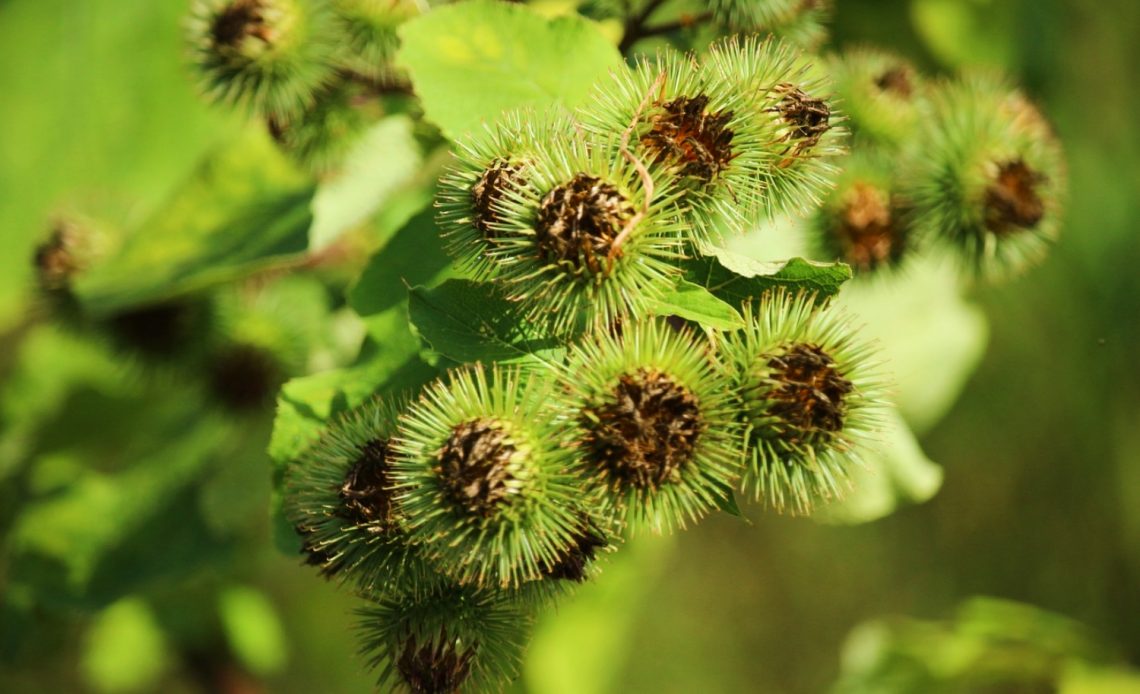

We’re here to help! Wild Yards is a completely free website that is 100% dedicated to helping you create a wildlife-friendly, sustainable yard. Read more
WildYards is reader-supported. When you buy a product through a link on our site, we may earn a comission. Every product is independently selected by our (obsessive) editors and our reviews are unbiased and objective. Read more about our mission or our privacy policy.
Everybody wants a healthy, thick lawn that feels as nice as new plush carpeting when you walk across it in your bare feet. No mushrooms in sight, no weeds sprouting up all over the place. Just dense turf as far as the eye can see. If you fertilize your lawn regularly and put your heart and soul into maintaining it, you may be shocked when you stumble into a bunch of stickers. These pesky, painful burrs can stand in the way of your perfect lawn dreams. But knowing which types of stickers in grass you’ve got will help you figure out how to get rid of them.
Burr stickers, lawn burweed, thistles, and burr medic are a few of the most common types of stickers in grass. Usually, the best way to eliminate them is to uproot them. But herbicides, salt, white vinegar, and boiling water can be used to kill them, too.
What are stickers?
Stickers, or sticker weeds, are plants that produce sharp, spiny foliage and/or spiked burrs, often called sticker burrs, that easily adhere to clothing, footwear, and animal fur. These pesky little burrs can make maintaining a healthy lawn an uphill battle. But why do plants produce such sharp foliage and burrs, anyway?
The reason plants produce spiked foliage is simple. They don’t want to be eaten! Their leathery, sharp-edged leaves are designed to prevent hungry foragers, like deer, from nibbling on them. Of course, deer can be pretty persistent, eating chewy oakleaf hydrangeas and even bursting pumpkins to get to the innards. So even though that seemingly inedible foliage may ward off some deer, it may not be enough to deter others.
As for all of those annoying burrs you find along your pant legs, those are seeds designed to spread by adhesion. Most burr-producing weeds are annuals, meaning they die back at the end of the growing season and must be propagated by seeds. Once the flowers of a burr-producing weed have been pollinated, they begin producing tender green burrs. As the burrs age, they soon dry up, turning white to tan in color, and becoming tough and spiny.
Walking through a patch of sticker burrs can be a painful experience, made all the more so if you’re not expecting it. If you’ve found dried sticker burrs in your yard, then the damage has been done. It would be virtually impossible to find them and collect them all before they sprout. The only thing you can do is control the damage.
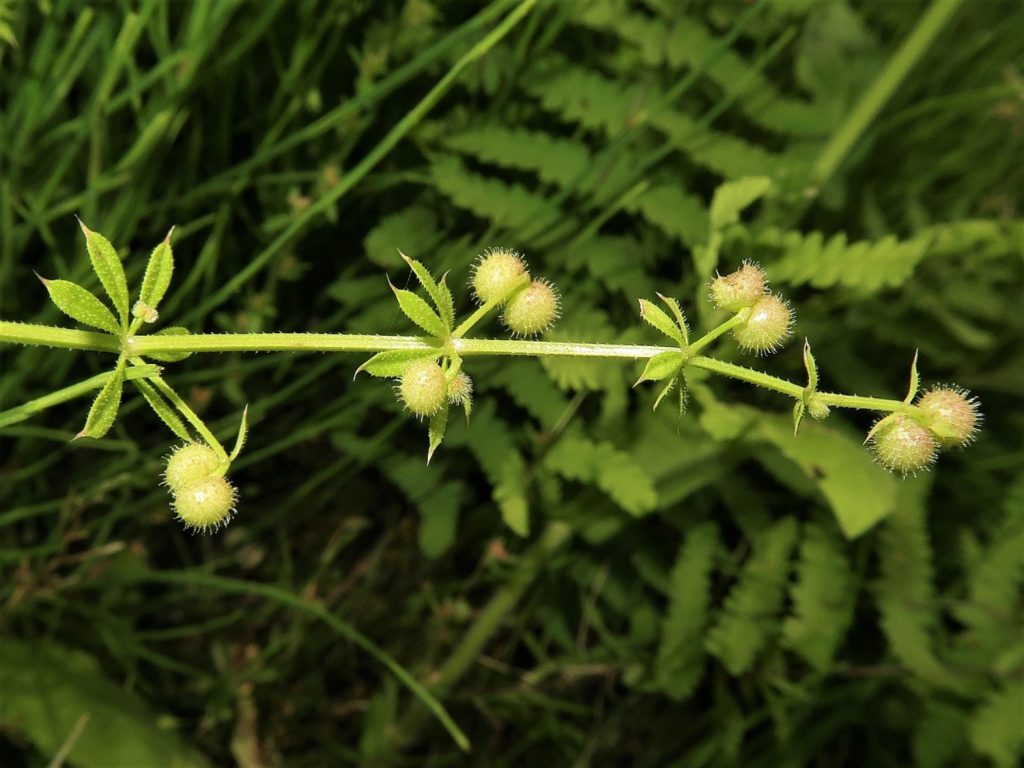
9 Different types of stickers in grass
Once you’ve determined that your lawn has a burr problem, it’s time to take a closer look. Examine your lawn closely to discover which types of burrs are hiding there. Knowing which of these weeds you’re dealing with will allow you to treat your lawn more effectively.
Burr stickers
An annual weed that thrives in warm, dry, Mediterranean-like climates, such as those found in the southern portion of the United States, burr stickers are often found in pastures, along roadways, and in gardens. This plant’s light green to yellow-green foliage makes it look just like regular old grass. But once burr stickers start producing seeds in late summer, there’s no mistaking them.
Burr stickers start out a vivid green, similar to the color of the plant itself. As the seeds age, they turn brown and dry up. The seeds are longer than they are wide, and oval in shape, making them look a bit like tiny pinecones. As the plants turn brown and die back, their seeds stand high above the withering foliage on tall spears, ready to latch onto humans and animals to be transported to a new location.
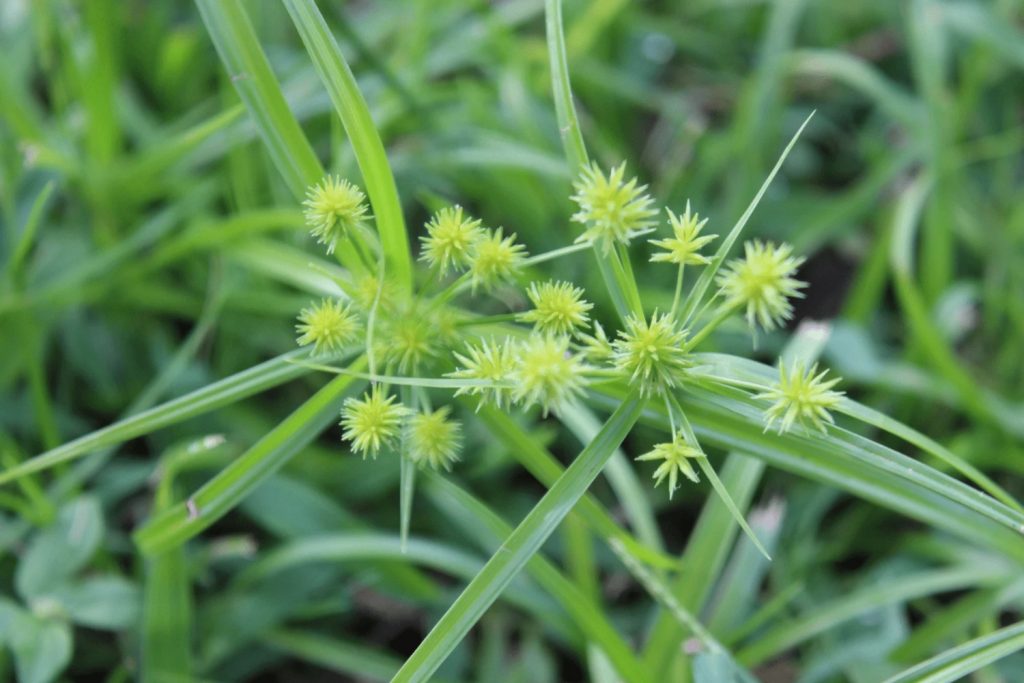
Field sandburr stickers
Like burr stickers, field sandburr stickers look like any other wild grass for most of the growing season. But, toward mid-summer, the plants start producing clusters of green burrs at the ends of tall stems that are immediately sharp and pointed.
Also known as sandspur, field sandburr stickers produce seeds that are painful to touch almost from the moment they first appear. These burrs, which are small, round, and covered in irregular, jagged spikes, are lighter and more yellow compared to the plant’s vibrant green foliage.
Field sandburr is an annual in most growing zones, but in warmer regions, it often grows as a perennial. It’s easy for this plant to propagate since its sharp burrs cling to passersby. Once your lawn has field sandburr stickers, it can be incredibly difficult to eradicate.
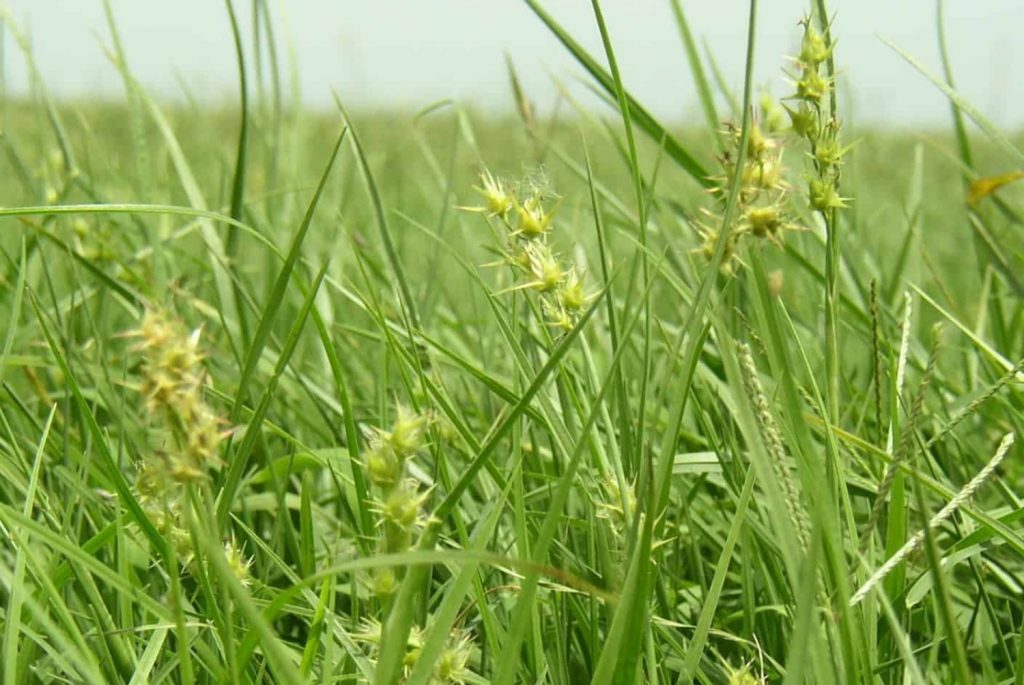
Thistles
The only good thing about thistles is that they’re easy to spot. These are a large type of stickers in grass that have a rosette leaf pattern. Plants produce tall stalks and long, ruffled leaves that look a lot like dandelion leaves. The leaves are blue-green to yellow-green and have jagged, spiny edges that cut through bare feet and leave scratches on your ankles and shins.
There are dozens of different types of thistle, but the most common include bull thistle, milk thistle, and yellow star thistle. Most thistles develop a reddish hue as they age, and as they near the end of the season, their stems turn brown. Plants produce yellow, pink, purple, and white flowers at the ends of their tall stalks. Once pollinated, the plants produce seed pods that are round and covered in spines. When the pods open, dozens of seeds emerge, each attached to a white, fuzzy “parachute” that’s easily picked up by the wind.
Thistles are considered noxious weeds, and, unfortunately, they’re so hardy and drought-resistant, they can be incredibly difficult to remove. These weeds are a major eyesore, and they’ll quickly take over your lawn if you don’t take measures to stop them quickly.
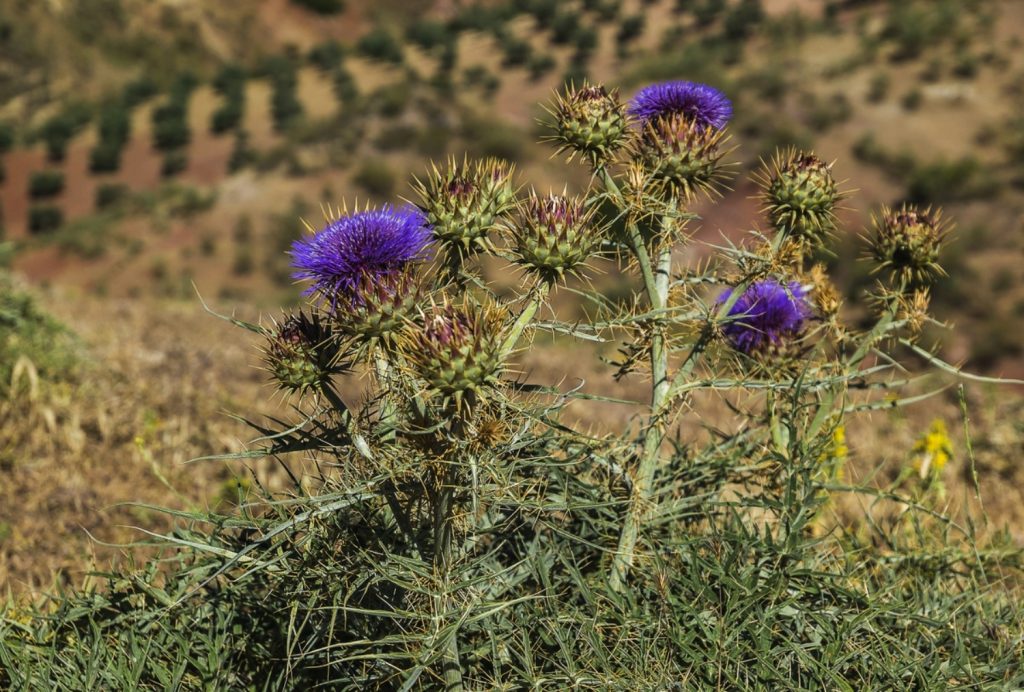
Cockleburr
A relative of the sunflower, cockleburr is an annual weed that grows in the summer months. In ideal conditions, cockleburr can grow up to 6 feet tall and it can quickly overtake a lawn, pasture, or vegetable garden. Cockleburr is toxic to livestock if ingested, which is just one of the many reasons why removing it is a good idea.
These types of stickers in grass are easy to spot. Cockleburr plants have a branching growth habit, with multiple brown, hairy stems growing from a single taproot. The plant’s large, rough leaves resemble those of a watermelon or squash plant, although they usually don’t grow as big. Cockleburr’s small, green flowers are hardly noticeable, but once pollinated, produce spiny round burrs, which latch onto wandering animals to be scattered elsewhere.
Cockleburrs die back every season, but they can leave behind huge quantities of seeds, which can remain in the soil for years. If you have a single cockleburr plant in your yard, it can give way to dozens more in the future.
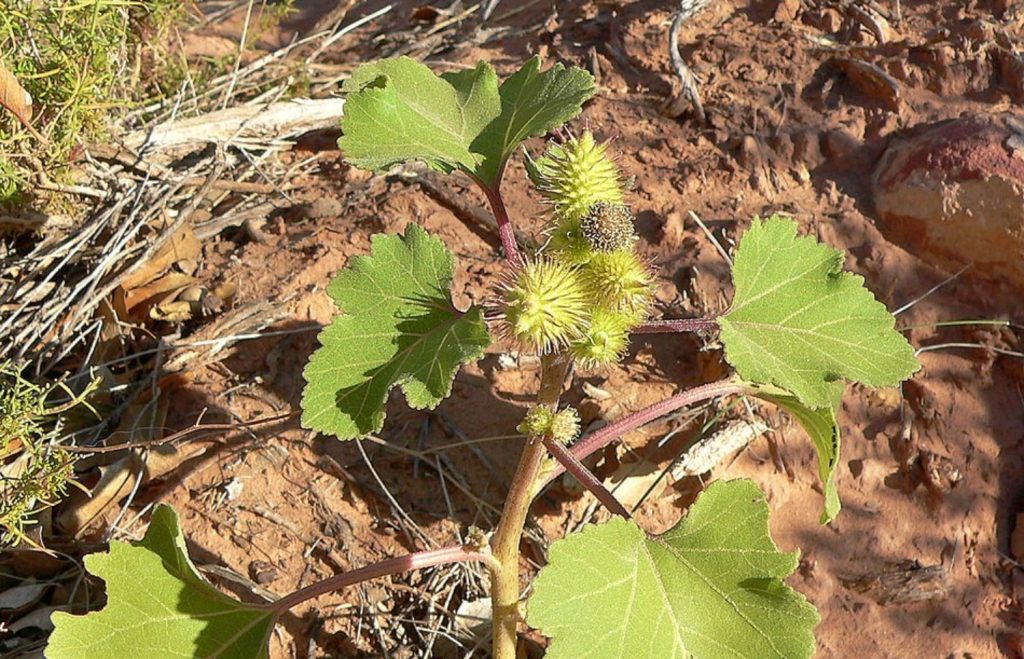
Burr medic
This type of sticker in grass looks a lot like clover, so much so that it is sometimes referred to as California burr clover. But burr medic is not a true clover. It’s actually a member of the pea family and is native to the Mediterranean region. Although unsightly and covered in painful burrs, burr medic can be a good thing for your lawn, especially if you’re interested in re-wilding your backyard.
Burr medic is an annual plant, and it’s considered a weed because it spreads rapidly and can be difficult to eradicate. Yet, despite its invasive nature, burr medic can be incredibly beneficial for your yard. Burr medic grows well in nitrogen-deficient soils, and, because it’s a legume, it improves nitrogen availability for surrounding plants, making it easier for your lawn to stay green and healthy.
This weed produces white to yellow flowers, which give way to small, spiny burrs once pollinated. Burr medic can make a real nuisance of itself if it isn’t kept in check. Its burrs easily become embedded in pet fur, socks, and other clothing. And because they’re so darn sharp, they can be tough to remove.
Goathead weed
Also called caltrop or cat’s head, goathead weed resembles another weed, purslane, and produces frond-like leaves emerging from a central point. Its delicate yellow, star-shaped flowers are quite popular with pollinating insects.
Goathead weed is named for the clusters of small, thorn-covered seeds it produces, which resemble a goat’s head. This plant’s painful barbs entangle themselves onto the fur and clothing of passersby, to be transported to new locations.
Goatweed thrives in dry, harsh environments where other plants can’t survive. It’s considered highly invasive, and its seeds can stay dormant in the soil for years, making it even more difficult to control.
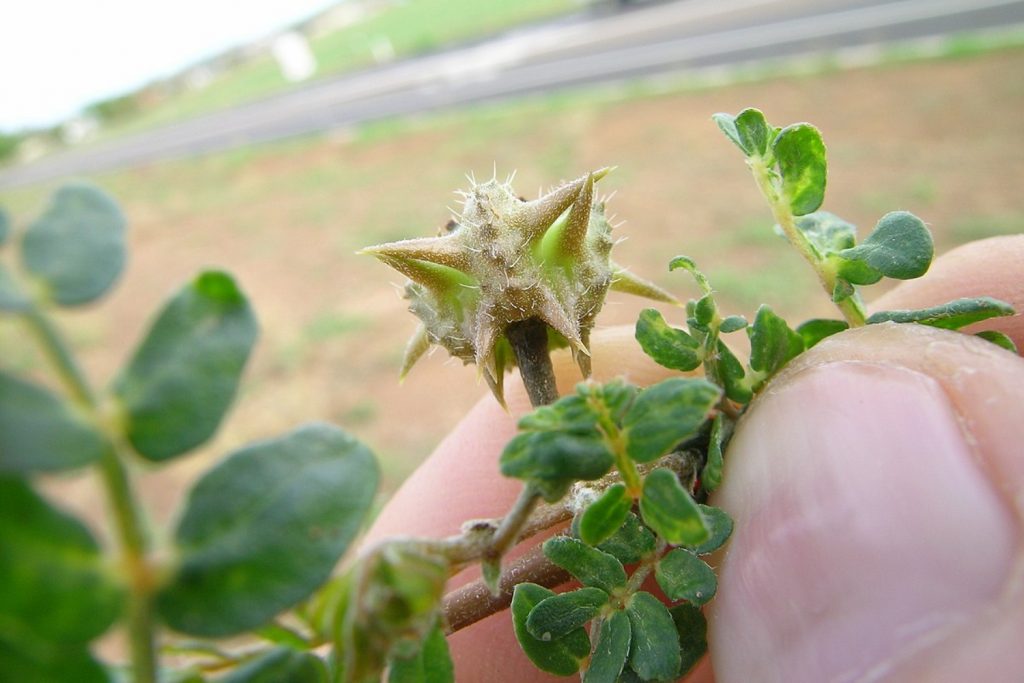
Lawn burrweed
One of the most common types of stickers in grass, lawn burrweed is a low-growing plant that acts like a ground cover, quickly spreading over a large area. Lawn burrweed grows well in shady spots, and moist soils, especially if they’re nutrient-rich.
At first glance, lawn burrweed looks a lot like dill or fennel. Its lacy, fern-like foliage tricks many homeowners into thinking it’s some kind of native herb. Lawn burrweed produces pale yellow to kelly green foliage and small round flower heads that yield little burrs, similar in size and appearance to burr medic’s stickers.
Lawn burrweed is an annual, commonly found in the southeastern states. This type of weed spreads rapidly in sandy, well-draining soils, where it competes with turf grasses and can be difficult to remove. Because lawn burrweed only grows about 3 to 4 inches tall, it can blend in with surrounding grass, making it difficult to see until you’re right on top of it. Keep your eyes open for this annual type of sticker in the grass with a rosette growing habit.
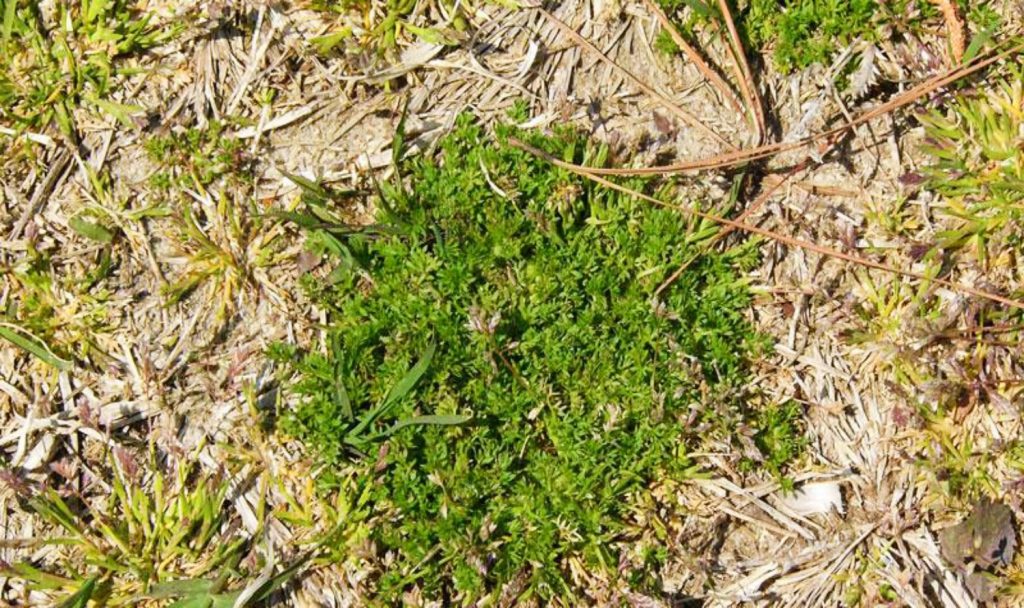
Burdock
Like thistles, burdock is pretty easy to spot. This plant’s large, spear-shaped leaves grow outward from a central point in a rosette pattern, which makes the plant look a lot like lettuce. The plant’s foliage is tough, leathery, and covered in prickly spines, both on the undersides and tops.
Burdock leaves have a rough, scratchy texture, and the plant’s distinctive burrs are equally irritating to the touch. Burdock burrs are round, tapering to a point at the end, and covered in long, uniform spines. Older burrs may feel soft and pliable. But newer ones are stiff and sharp. You may find them trapped in your dog’s fur or dotting your horse’s lower legs.
Burdock is prized among backyard foragers for its medicinal properties. This plant is often used to treat digestive ailments as well as arthritis. But if you’re more interested in growing a pretty lawn than gathering weeds, getting rid of them should be your top priority. Burdock is a biennial that spreads via seeds and shoots, making it doubly hard to combat.
Stickseed
Also known as beggar’s lice, stickseed is a member of the borage family, so this native plant is very popular with pollinating insects. Stickseed produces small blue or purple flowers, nestled among hairy leaves that can be irritating to sensitive skin. These types of stickers in grass are commonly found in pastures, parks, and along roadways.
After blooming, stickseed plants produce tiny burrs along the edges of their tall stalks. This annual grows 1 to 3 feet tall in ideal conditions. Because the stems are so delicate, and because the hook-like spines of the burrs are so strong, it’s not unusual to find the entire end of the plant stuck to your pants, socks, or shoes.
Stickweed grows best in spots that receive full to partial sunlight, and they are tolerant of a broad range of soil types, meaning they can be found almost anywhere. Like burdock, stickweed has medicinal properties and is often used to treat skin conditions. However, left unchecked, it can quickly take over your turf and undo years of careful lawn maintenance.
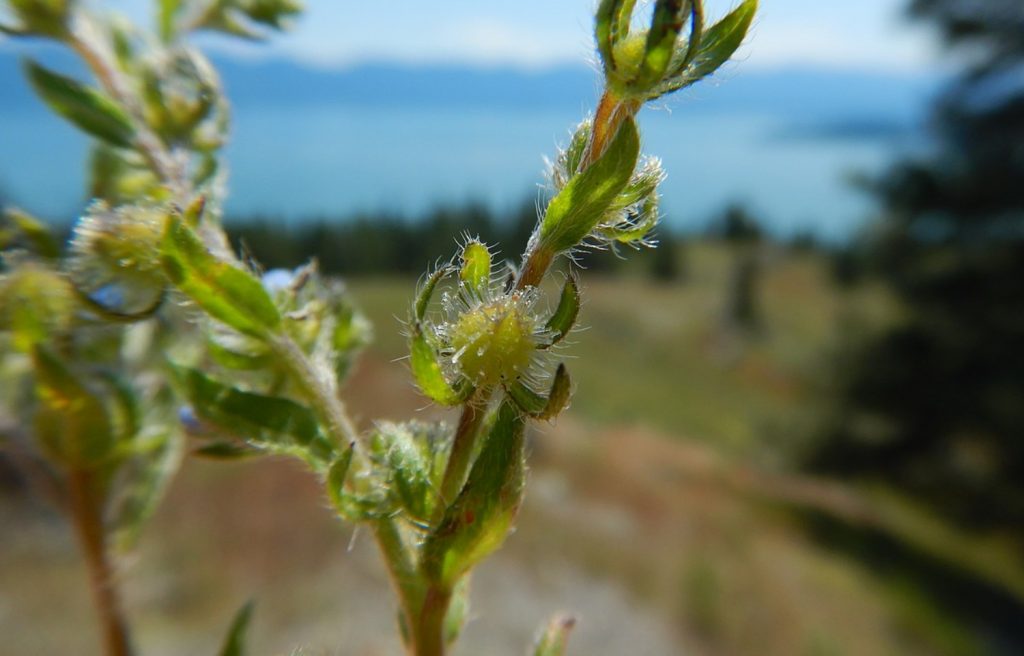
How can you get rid of the different types of stickers in grass?
Once you have a better idea of what types of stickers in grass you’re dealing with, you can tackle the problem efficiently and effectively. Here are some of the most tried-and-true methods for removing those irritating weeds and their annoying burrs.
Pull them up by hand
Time-consuming? Yes. Effective? Also yes. Pulling up the weeds in your yard by hand may sound like a major chore. And, to be sure, weeding a lawn by hand is hard work. But this is also the most effective way to eliminate those pesky plants from your yard.
Pulling up weeds works best before the plants have gone to seed. So you’ll need to inspect your yard carefully in the spring, right as the weeds are coming up and uproot them as soon as possible, being careful to remove as much of their root systems as you can. Use a weed fork and/or a trowel to wriggle the entire plant out of the soil.
As long as the weeds haven’t gone to seed, they’re safe to add to your compost bucket or heap. Putting plants that have already sprouted burrs into your compost bin is just setting yourself up for failure later on when you use the compost to feed the plants in your garden or flower beds.
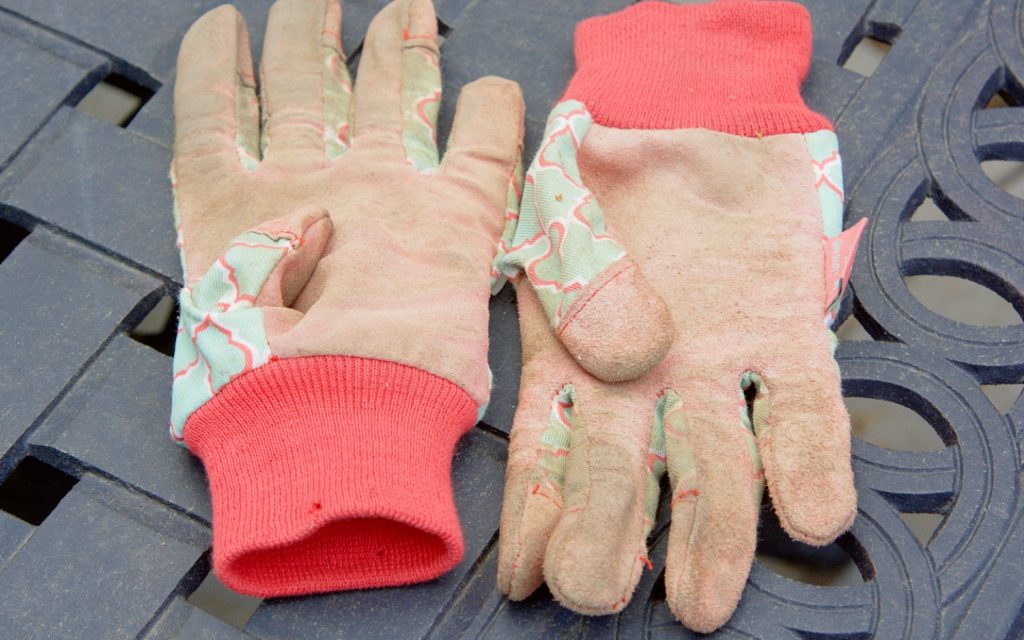
Spray them with white vinegar
Vinegar contains acetic acid, which can kill the tops of plants and, eventually, the roots. Acetic acid disrupts the delicate pH of a plant’s cells, resulting in significant damage to the outer membrane. With no protection, the cells dry up, causing the plant to die back.
Simply spray white vinegar onto the weeds you want to eliminate, being sure to cover all of the plant’s foliage. Vinegar is an organic herbicide, a pet-safe option that poses no threat to wildlife. However, it does kill indiscriminately. So if you’re not careful when using it to spray weeds, it can also kill surrounding grass.
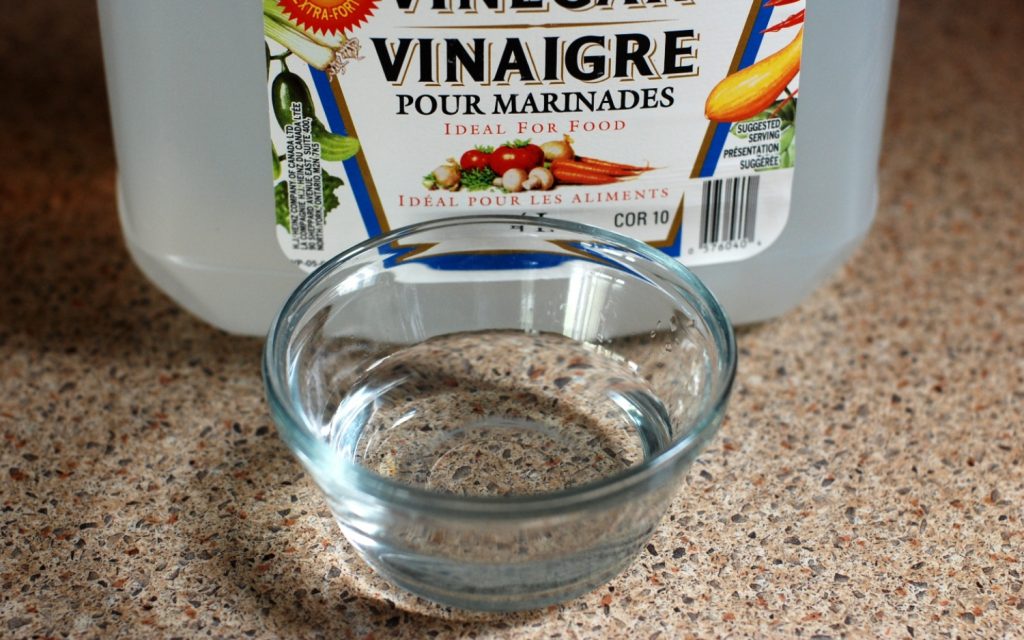
Sprinkle them with salt
Like vinegar, salt dries weeds out by damaging the plant’s cells. When applied to the soil and/or foliage, salt draws moisture out of the plant in a process called osmosis, which causes them to dehydrate. Salt also disrupts the plant’s pH balance, making it difficult for them to absorb the nutrients and water they need to produce plant food.
Salt can be incredibly effective for dealing with all types of stickers in grass. Unfortunately, it is not suitable for long-term use. Over time, salt can damage soil structure. Salt creates an inhospitable soil environment for plants, and can pollute nearby waterways. So if you choose this method to eliminate the weeds in your yard, use it conservatively.
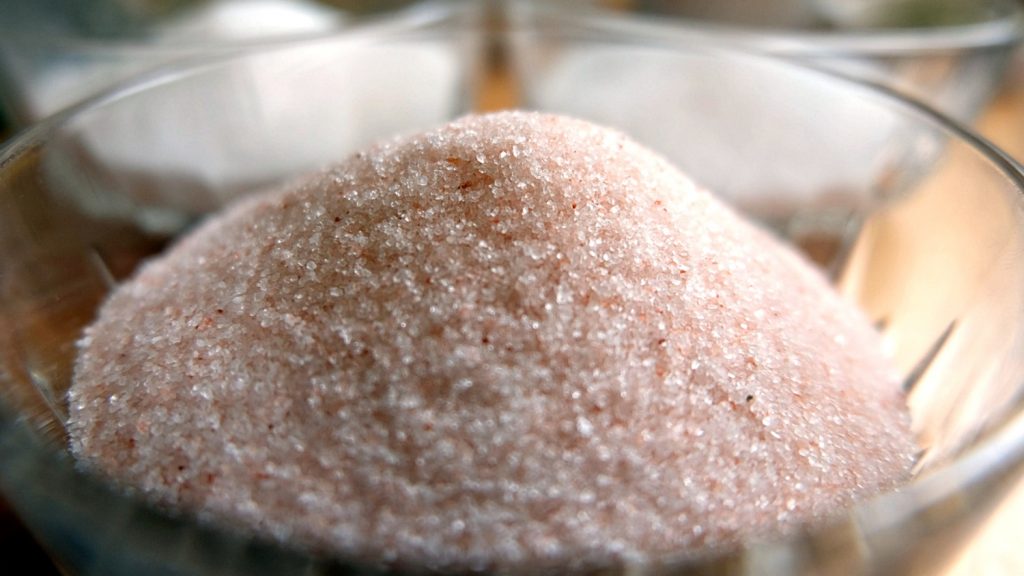
Pour boiling water over them
Plants are as sensitive to temperature as any other living them. Extreme heat can kill all types of stickers in grass, which means pouring boiling water over them can be a highly effective means of eliminating them — especially solitary weeds, like thistles.
The process is about as simple as it sounds. Just pour a saucepan full of boiling water over the weeds, and they should die back within a day or so. Of course, you’ll want to be careful when pouring the boiling water. Use as much as is necessary, but as little as possible to avoid scalding surrounding plants. Like salt and vinegar, boiling water will kill any vegetation, not just weeds.

Use an herbicide
When all else fails, invest in a good herbicide. Pre-emergence herbicides can help you eliminate all types of stickers before they even get a chance to sprout up in your lawn. Benefin and Oryzalin work best. Just be sure to follow the manufacturer’s instructions to stay safe and maximize the effectiveness of these types of herbicides.
If the stickers have already sprouted up on your lawn, then you’ll need a post-emergence herbicide to control the population. Monosodium methanearsonate (MSMA) herbicides can be used to control broad-leaf and weed grasses. Use this type of herbicide at any time once you’ve spotted sticker weeds in your lawn. Once again, be sure to follow the manufacturer’s instructions to avoid overapplication.
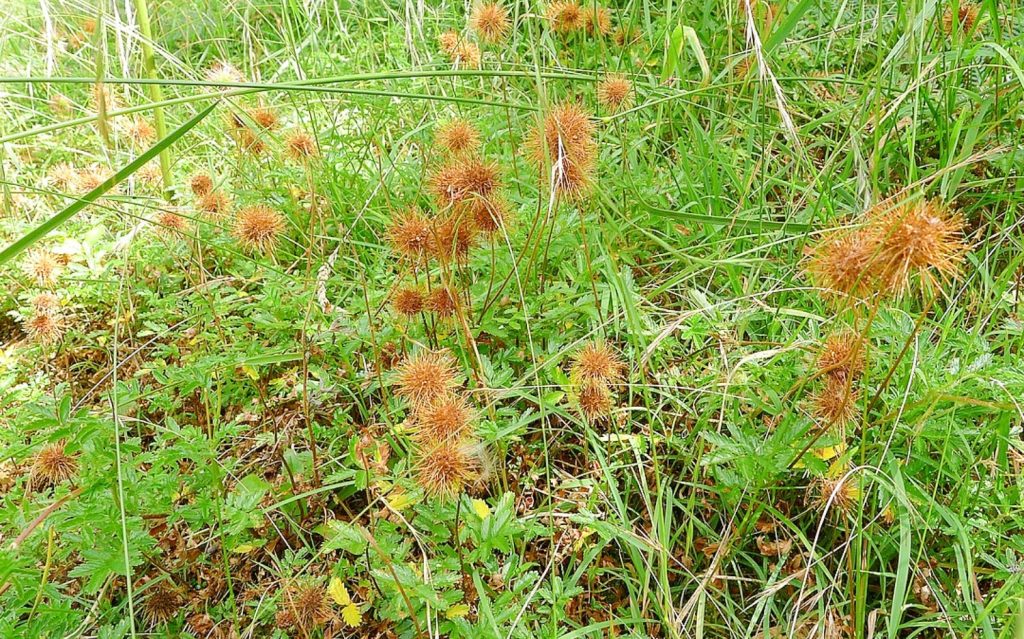
Try flame weeding
If you’re a fan of organic gardening and a devout follower of Ruth Stout, then chemical-based herbicides may not be right for you. But have you considered using a flame thrower instead? A hand-held propane torch can be used to remove all types of sticker weeds in grass, but is particularly helpful for ground cover type weeds, like goathead weed, lawn burrweed, and burr medic.
Hand-held torches make it easy to spot treat your lawn for weeds. Scorching the plants from the top down is one of the most effective means of getting rid of them. This enables you to neutralize the weeds, preventing them from regrowing, while still allowing them to biodegrade back into the soil, where they can feed the grass in your lawn.
Fertilize and mow regularly
Weed prevention starts with a healthy lawn. By mowing your grass regularly and fertilizing it annually, you’ll be doing everything you can to stimulate strong, thick growth. If your lawn is in great shape — growing nice and thick with no bare patches — then it will be much more difficult for types of stickers to take root and sprout in grass.
Dethatching your lawn every other growing season can make a tremendous difference, too. Thatch is a layer of dead foliage that builds up, reducing aeration to the soil. Burrs and seeds can get trapped in this layer, where they’ll be free to sprout in a growing season or two. Removing the thatch, and the burrs and seeds inside of it can enhance your lawn’s performance while also preventing weeds.
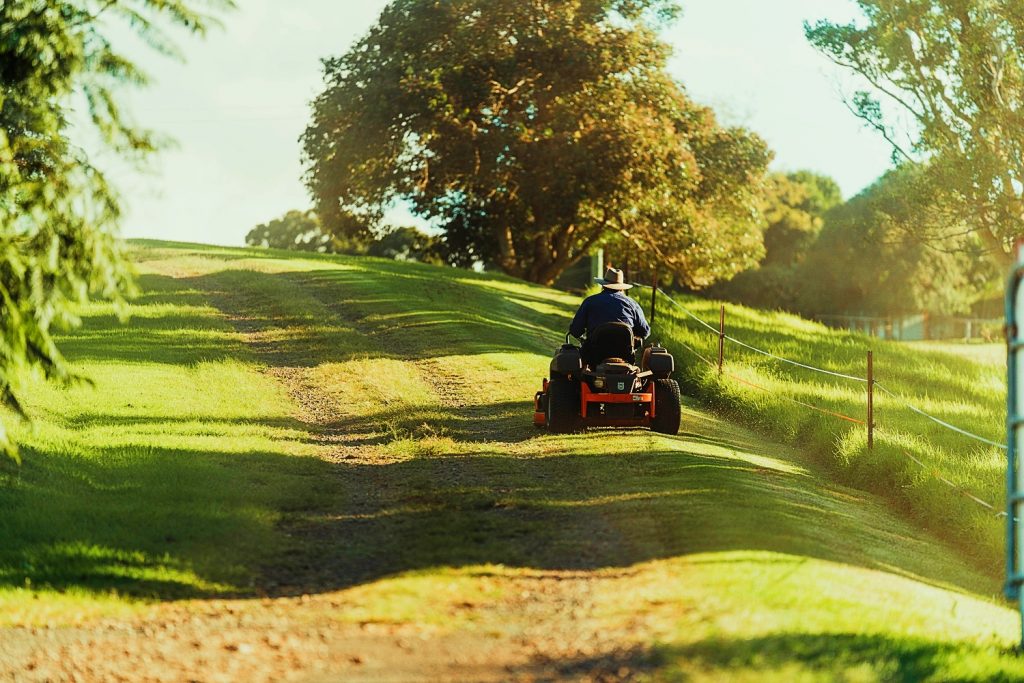
More tips for removing all types of stickers in grass
In addition to regularly fertilizing and mowing your lawn, there are a few additional tips for keeping your grass in tip-top shape. Be sure to water your lawn deeply, but infrequently, to encourage deep root systems that can quickly snuff out germinating weeds. Aerating the soil biannually will also promote strong root development by increasing oxygen and water flow to the ground below.
By keeping a watchful eye on your lawn, and by taking steps to promote healthy grass, you’ll be doing everything you can to eliminate all types of stickers in grass.
